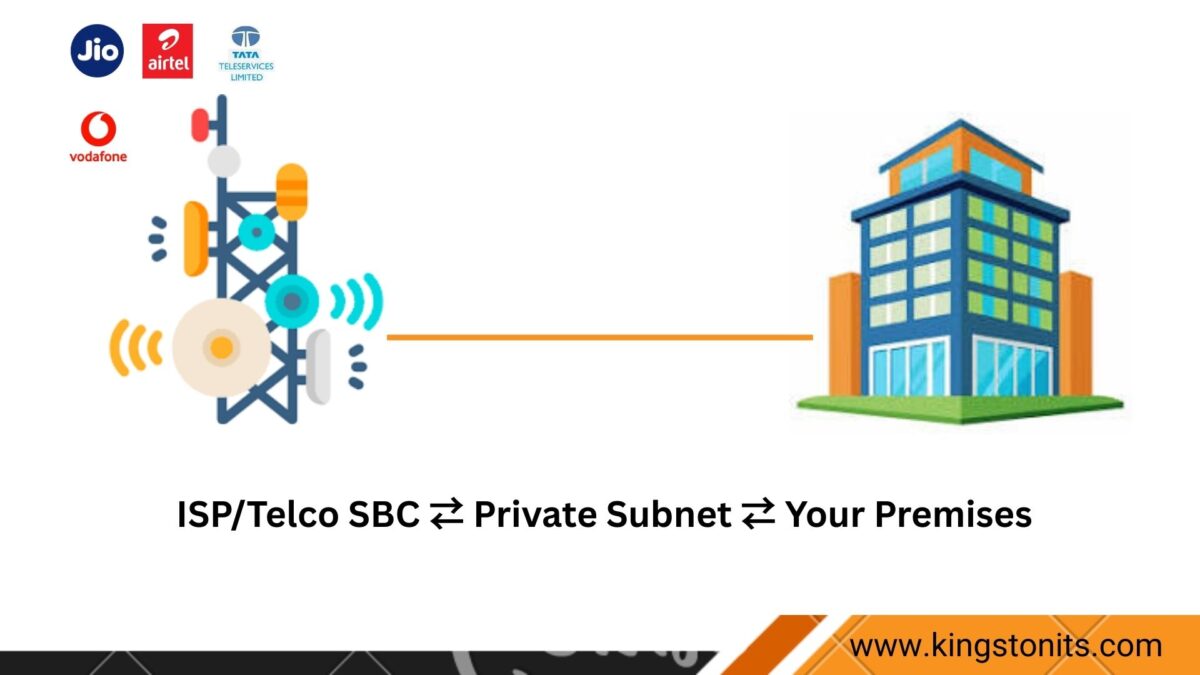How to Connect Your Telco SIP/PRI to a Cloud PBX (Azure/AWS/Datacenter)

In many countries, telecom operators provide SIP trunks as a PSTN replacement service, typically delivered over fiber or wireless links. These SIP trunks are usually bound to a private subnet at customer premises, meaning you cannot directly register them from a Cloud PBX in Azure, AWS, or other datacenters.
So, how can you securely connect your cloud PBX to your provider’s SIP trunk? Let’s explore two practical options.
⚠️ Disclaimer
This post is for informational purposes only. Telecom regulations and licensing differ by country and provider. Always:
- Verify with your service provider before implementing.
- Follow your local telecom laws and licensing requirements.
- Ensure proper security to avoid toll fraud.
- Kingston IT Solution assumes no liability for misuse or financial loss.
The Problem
Telecom SIP trunks are typically delivered to your premises using a private IP subnet. For example:
- Telco SBC ⇄ Private Subnet ⇄ Your Premises
Since your Cloud PBX is not in the same subnet, it cannot directly connect.
📌 Solution: Introduce a bridge between your telco and your Cloud PBX.
Two Possible Options
1. Deploy an SBC (Session Border Controller)
An SBC sits between the telco and your cloud PBX.
Architecture:
- Telco SIP ⇄ SBC (private side)
- SBC ⇄ Cloud PBX (public IP or VPN)
Features of SBCs:
- SIP normalization
- TLS/SRTP encryption
- Topology hiding
- Call admission control
- DoS/DDoS protection
✅ Pros: Enterprise-grade, reliable, telco-approved.
❌ Cons: Costly and requires expertise.
2. Use an Asterisk Server as a Mediator
The cost-effective approach is to use Asterisk on-premises as a B2BUA (Back-to-Back User Agent).
Architecture:
- Telco SIP ⇄ Asterisk (private side)
- Asterisk ⇄ Cloud PBX (public IP or VPN)
Benefits:
- Low-cost, flexible, quick to deploy
- Acts as signaling and media bridge
- Supports SIP-TLS, SRTP, and ACLs
✅ Pros: Budget-friendly, easy to set up
❌ Cons: Needs strong security hardening
Security Checklist ✅
No matter which option you use, implement these protections:
- Restrict SIP access by IP allowlists
- Strong SIP passwords (disable guest access)
- Use SIP-TLS + SRTP whenever possible
- GeoIP firewall rules (block unused regions)
- Outbound dialing restrictions (avoid premium/international fraud)
- Fail2ban or IDS to block SIP scanners
- Call rate limits and monitoring alerts
Network Paths to Cloud PBX
You can connect your Cloud PBX to your premises in three ways:
- Public IP with ACLs — Lock down access to specific IPs.
- Site-to-Site VPN — IPSec/WireGuard tunnel.
- Private connectivity — MPLS, ExpressRoute, or AWS Direct Connect.
Call Flow Example (Asterisk Mediator)
- Telco SBC → Asterisk (private LAN)
- Asterisk → Trunk to Cloud PBX
- Cloud PBX → Extension anywhere (softphone, IP phone, WebRTC)
- Outbound calls → Cloud PBX → Asterisk → Telco
Final Thoughts
- SBC: Best for enterprises needing compliance and high-scale features.
- Asterisk: Perfect for SMBs that want a secure and affordable bridge.
At Kingston IT Solution, we help businesses design SIP trunk connectivity to Cloud PBX solutions—whether on Azure, AWS, or hybrid datacenters.
Call to Action
👉 Need help bridging your SIP trunk to the cloud? Contact Kingston IT Solution today.
